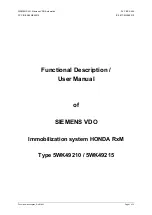
e1276e
16
Siemens Building T
echnologies
Cerberus Division
09.2000
3.8.3
Possible diagnosis results
1. Fire
The detector registered a signal which corresponded to a normal fire with the necessary
extinction and activated an alarm.
If this turns out to be a false alarm, then most probably an aerosol was present in the room
which simulated the development of a genuine fire and caused the necessary extinction.
Possible remedy:
– Less sensitive setting
2. Slowly developing fire
The detector registered a signal which corresponded to a slowly developing fire and upon
sufficient extinction activated an alarm.
In the event of a false alarm the diagnosis could point to possible condensation.
Possible remedy:
– Install detector heating
–
Less sensitive setting
3. Thermal turbulence / electromagnetic interference (EMI)
Thermal turbulence points to powerful air circulation. This is mainly caused by air hea-
ters, baking ovens, furnaces etc.
Thermal turbulence and/or powerful electromagnetic interference generate “noise”
which is filtered out by the algorithms. However, if it exceeds a certain strength and dura-
tion, it can still lead to detector impairment.
Possible remedy:
– Remove detectors from such an environment.
4. Repeated interruption
Repeated interruption of the beam is caused by moving objects, such as cranes, ladders,
decorations etc. or also by powerful electromagnetic interference which has an effect on
the detector.
Normally, in time this leads to fault signals being activated, but also results in unwanted
alarms.
Possible remedy:
– Such applications must be avoided
5. Test filter
If the test filter is held in the infrared beam, it causes a sudden decrease in signal strength
without however, reaching zero.
This characteristic causes the detector to activate an alarm after approx. 10s.
















































